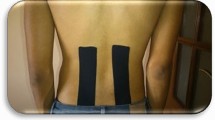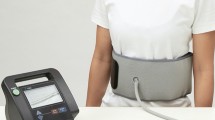Abstract
The aim of this trial is to investigate and compare the effects of electrical stimulation (ES) program and ultrasound (US) therapy on pain, disability, trunk muscle strength, walking performance, spinal mobility, quality of life (QOL), and depression in the patients with chronic low back pain (CLBP). A total of 59 patients with definite CLBP were enrolled in this study. These patients were randomized into three groups. Group 1 (n = 20) was given an ES program and exercises. Group 2 (n = 19) was given an US treatment and exercises. Group 3 (n = 20) was accepted as the control group and was given only exercises. All of the programs were performed 3 days a week, for 6 weeks. The patients were evaluated according to pain, disability, walking performance, endurance, mobility, QOL, depression. The trunk muscle strength was measured with a hand-held dynamometer. All of the groups showed stastically significant improvements in pain, disability, muscle strength, endurance, walking performance, mobility, sub-scores of SF 36, and depression when compared with their initial status. The intergroup comparison showed significant difference in physical function, energy and social function sub-groups of SF-36, VAS pain, extensor muscle strength, between three groups. This difference was statistically significant in the groups 1 and 2 compared to the control group. There was also no significant difference between the groups 1 and 2. We observed that US treatment and ES treatment were effective in improving pain, isometric extensor muscle strength, and QOL in patients with CLBP.









Similar content being viewed by others
References
Frank AO, Souza LD (2001) Conservative management of low back pain. Int J Clin Pract 55:21–31
Uden A, Aström M, Bergenudd H (1988) Pain drawings in chronic back pain. Spine 13:389–392
Nicolaisen T, Jorgensen K (1985) Trunk strength, back muscle endurance, and low-back trouble. Scand J Rehab Med 17:121–127
Mayer TG, Smith SS, Keeley J et al (1985) Quantification of lumbar function. Part 2. Sagittal plane trunk strength in chronic low-back pain patients. Spine 10:765–772
Liddle SD, Baxter GD, Gracey JH (2004) Exercise and chronic low back pain: what works? Pain 107:176–190
Rainville J, Hartigan C, Martinez E et al (2004) Exercise as a treatment for chronic low back pain. Spine J 4:106–115
Liberson WT (1984) Electrotherapy. In: Ruskin AP (ed) Current therapy in physiatry. W.B. Sounders Company, Philadelphia, pp 161–191
Philadelphia Panel evidence-based clinical practice guidelines on selected rehabilitation ınterventions for low back pain (2001) Phys Ther 81:1641–1674
Harris GR, Susman JL (2002) Managing musculoskeletal complaints with rehabilitation therapy: summary of the Philadelphia Panel evidence-based clinical practice guidelines on musculoskeletal rehabilitation interventions. J Fam Pract 51:1042–1046
Grubisic F, Grazio S, Jajic Z et al (2006) Therapeutic ultrasound in chronic low back pain treatment. Reumatizam 53:18–21
Melzack R, Vetere P, Finch L (1983) Transcutaneous electrical nerve stimulation for low back pain: A comparison of TENS and massage for pain and range of motion. Phys Ther 63:489–493
Rutkowski B, Neidzialkowska T, Otto J (1977) Electrical stimulation in chronic low back pain. Br J Anaesth 49:629–632
Durmus D, Akyol Y, Alayli G et al (2008) Effects of electrical stimulation program on trunk muscle strength, functional capacity, quality of life, and depression in the patients with low back pain: a randomized controlled trial. Rheumatol Int Dec 20 (Epub ehead of print)
Durmus D, Alayli G, Canturk F (2007) Effects of quadriceps electrical stimulation program on clinical parameters in the patients with knee osteoarthritis. Clin Rheumatol 26:674–678
Kahanovitz N, Nordin M, Verderame R et al (1987) Normal trunk muscle strength and endurance in women and the effects of exercises and electrical stimulation. Spine 12:112–118
Koldaş Doğan S, Sonel Tur B et al (2008) Comparison of three different approaches in the treatment of chronic low back pain. Clin Rheumatol 27:873–881
Kääpä E, Frantsi K, Sarna S et al (2006) Multidisciplinary group rehabilitation versus ındividual physiotherapy for chronic nonspecific low back pain: a randomized trial. Spine 31:371–376
Duruöz MT, Ozcan E, Ketenci A et al (1999) Cross cultural validation of the revised Oswestry pain questionnaire (ROPQ) in a Turkish population. Arthritis Rheum 42(9). (Annual Scientific Meeting. Boston, Massachusetts, P1200)
Grönblad M, Hupli M, Wennerstrand P et al (1993) Intercorrelation and test-retest reliability of the pain disability index (PDI) and the oswestry disability questionnaire (ODQ) and their correlation with pain intensity in low back pain patients. Clin J Pain 9:189–195
Macrael IF, Wright V (1969) Measurement of back movement. Ann Rheum Dis 28:584
Ito T, Shirado O, Suzuki H et al (1996) Lumbar trunk muscle endurance testing: an inexpensive alternative to a machine for evaluation. Arch Phys Med Rehabil 77:75–79
McGill SM, Childs A, Liebenson C (1999) Endurance times for low back stabilization exercises clinical targets for testing and training from a normal database. Arch Phys Med Rehabil 80:941–944
Kvien TK, Kaasa S, Smedstad LM (1998) Performance of the Norwegian SF-36 Health Survey in patients with rheumatoid arthritis. II. A comparison of the SF-36 with disease-specific measures. J Clin Epidemiol 51:1077–1086
Beck AT, Ward CH, Mendelson M et al (1961) An inventory for measuring depression. Arch Gen Psychiatry 4:561–571
Wheeler AH (1995) Diagnosis and management of low back pain and sciatica. Am Fam Physician 52:1333–1341
Cailliet R (1981) Low back pain syndrome. FA Davis, Philadelphia, pp 206–225
Mannion AF, Müntener M, Taimela S et al (2001) Comparison of three active therapies for chronic low back pain: results of a randomized clinical trial with one-year follow-up. Rheumatol 40:772–778
Taimela S, Diederich C, Hubsch M et al (2000) The role of physical exercise and inactivity in pain recurrence and absenteeism from work after active outpatient rehabilitation for recurrent or chronic low back pain. Spine 25:1809–1816
Bayramoglu M, Akman MN, Kilinç S et al (2001) Isokinetic measurement of trunk muscle strength in women with chronic low-back pain. Am J Phys Med Rehabil 80:650–655
Robertson VJ, Baker KG (2001) A review of therapeutic ultrasound: effectiveness studies. Phys Ther 81:1339–1350
Unlu Z, Tasci S, Tarhan S et al (2008) Comparison of 3 physical therapy modalities for acute pain in lumbar disc herniation measured by clinical evaluation and magnetic resonance imaging. J Manipulative Physiol Ther 31:191–198
Lehmann JF, De Lateur BJ (1990) Therapeutic heat. In: Lehmann JF (ed) Therapeutic heat and cold. Wiliams and Wilkins, Baldimore, pp 417–562
Lehmann JF, Bunner GD, Stow RW (1958) Pain threshold measurements after therapeutic application of ultrasound, microwaves and infrared. Arch Phys Med Rehabil 39:560–565
Québec Task Force on Spinal Disorders (1987) Scientific approach to the assessment and management of activity-related spinal disorders: a monograph for clinicians. Spine 12:51–59
Gaines JM, Metter EJ, Talbot LA (2004) The effect of neuromuscular electrical stimulation on arthritis knee pain in older adults with osteoarthritis of the knee. Appl Nurs Res 17:201–206
Conflict of interest
None.
Author information
Authors and Affiliations
Corresponding author
Rights and permissions
About this article
Cite this article
Durmus, D., Durmaz, Y. & Canturk, F. Effects of therapeutic ultrasound and electrical stimulation program on pain, trunk muscle strength, disability, walking performance, quality of life, and depression in patients with low back pain: a randomized-controlled trial. Rheumatol Int 30, 901–910 (2010). https://doi.org/10.1007/s00296-009-1072-7
Received:
Accepted:
Published:
Issue Date:
DOI: https://doi.org/10.1007/s00296-009-1072-7




